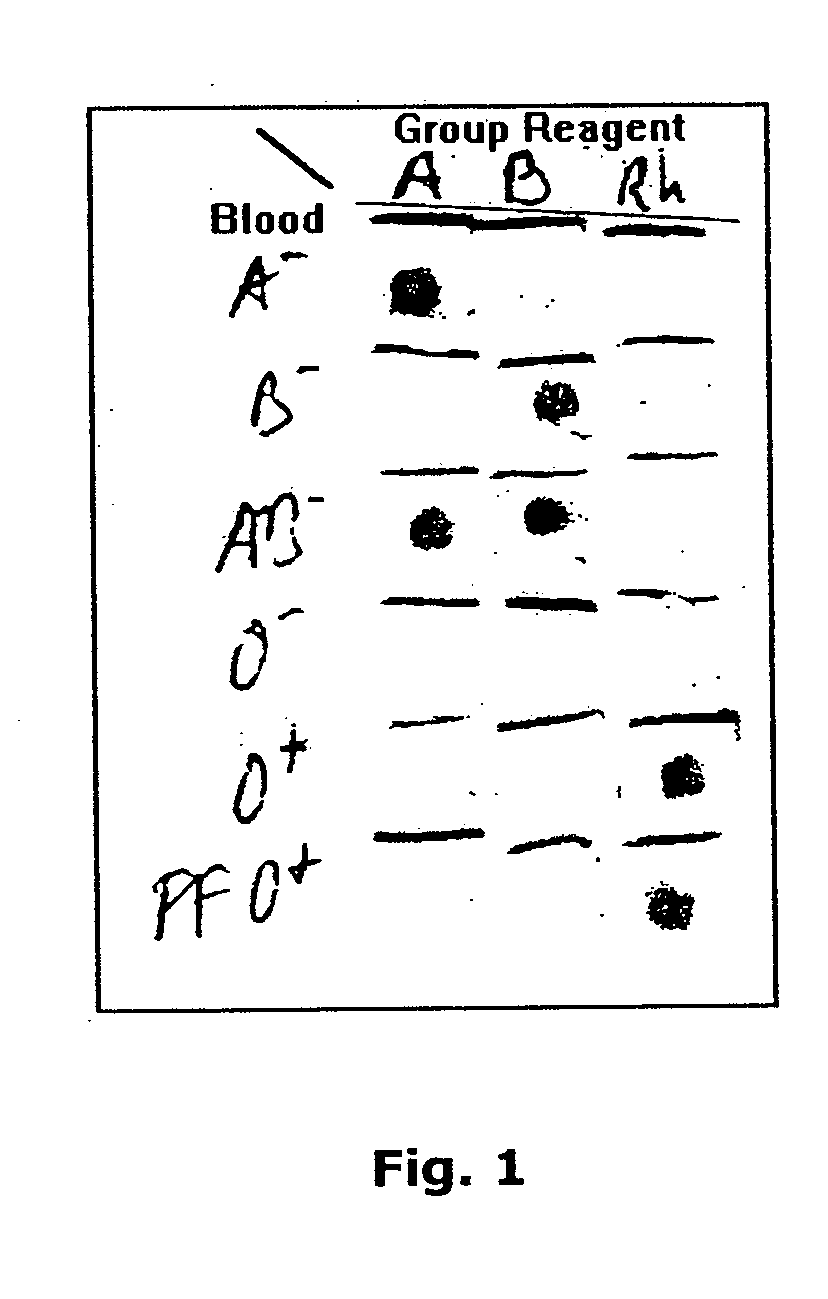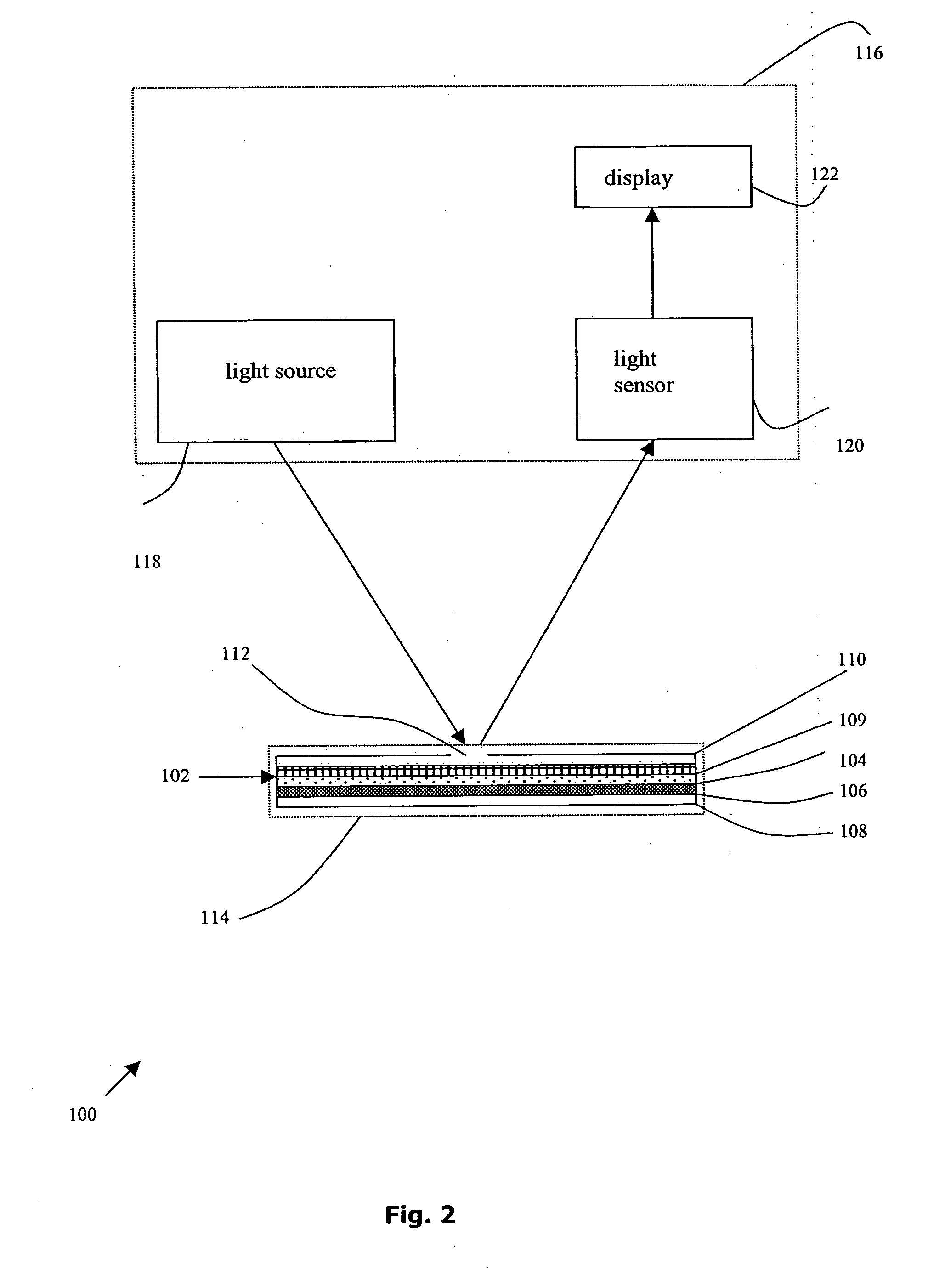Particle agglutination detection method and device
a particle agglutination and detection method technology, applied in the field of receptorligand interaction detection, can solve the problems of not teaching or suggesting art, and achieve the effect of simple use, fast and accurate results, and avoiding false positive results
- Summary
- Abstract
- Description
- Claims
- Application Information
AI Technical Summary
Benefits of technology
Problems solved by technology
Method used
Image
Examples
example 1
Wash Solutions
[0143] Wash solutions used in generating the examples were:
[0144] Dulbecco's Phosphate Buffered Saline (PBS), obtained from Biological Industries, Beit Ha'emek, Israel.
[0145] A solution made from 1:1 diluted PBS in water with 4% w / v Poly Ethylene Glycol (PEG) 15000-20000MW (Fluka) and 0.3% w / v dextran sulfate sodium salt (Amersham Biosciences).
[0146] A. Dulbecco's Phosphate Buffered Saline (PBS) with 0.001-0.01% w / v polyoxyethylene-10-tridecyl ether (Sigma).
example 2
Blood Grouping
[0147] A 0.5×0.5 cm piece of Ahlstrom #142 filter paper was placed on an absorbent pad. Two μL of whole blood were pipetted in the center of the filter and followed by 2 μL of an anti-blood group reagent (Gamma Biologicals Inc., Hosuton, Tex., USA). The filter was then washed with a few drops (from a dropper bottle) of a wash solution and dried. Alternatively, a 4 mm diameter circle of the Ahlstrom #142 filter paper, 10 μL of blood and 10 μL of the anti-blood group reagent were used followed by few drops of wash solution C from Example 1.
[0148] This test was repeated with multiple blood specimens of various blood groups (received from and pre-tested by the Central Blood Services, Israel Red Magen David, Tel Hashomer, Israel) and each of these was tested with anti-A, anti-B, anti-AB and anti-D (=Rh) blood group reagents. The A− blood generated a red spot only with anti-A and anti-AB reagents. The B− blood generated a spot with the anti-B and anti-AB reagents. The AB− ...
example 3
Blood Grouping with Dried Reagents
[0149] 0.5×0.5 cm pieces of Ahlstrom #142 filter paper were placed on a non absorbent surface (bottom of empty, disposable Petri dishes). A 50 μL aliquot of an anti-blood group reagent (Gamma Biologicals Inc., Hosuton, Tex., USA) was pipetted on each of the pieces of filter paper. The Petri dishes with the anti-blood group reagents containing filter pieces were incubated overnight at 37° C. The filter pieces were dry at that time.
[0150] For testing the ability of the dried, antibody impregnated pieces to correctly identify the blood grouping of whole blood specimens, they were placed on an absorbent pad and a 1 μL aliquot of the test blood was placed in the approximate center of each of a series of filter pads. The series included pads, each impregnated with either one of anti-A, anti-B or anti-D (=Rh) reagent.
[0151] Excess blood was washed from the filter pads by placing 5-10 drops of either wash solution A or B. The filter pieces were then air ...
PUM
| Property | Measurement | Unit |
|---|---|---|
| Flow rate | aaaaa | aaaaa |
| Concentration | aaaaa | aaaaa |
| Volume | aaaaa | aaaaa |
Abstract
Description
Claims
Application Information
 Login to View More
Login to View More - R&D
- Intellectual Property
- Life Sciences
- Materials
- Tech Scout
- Unparalleled Data Quality
- Higher Quality Content
- 60% Fewer Hallucinations
Browse by: Latest US Patents, China's latest patents, Technical Efficacy Thesaurus, Application Domain, Technology Topic, Popular Technical Reports.
© 2025 PatSnap. All rights reserved.Legal|Privacy policy|Modern Slavery Act Transparency Statement|Sitemap|About US| Contact US: help@patsnap.com


